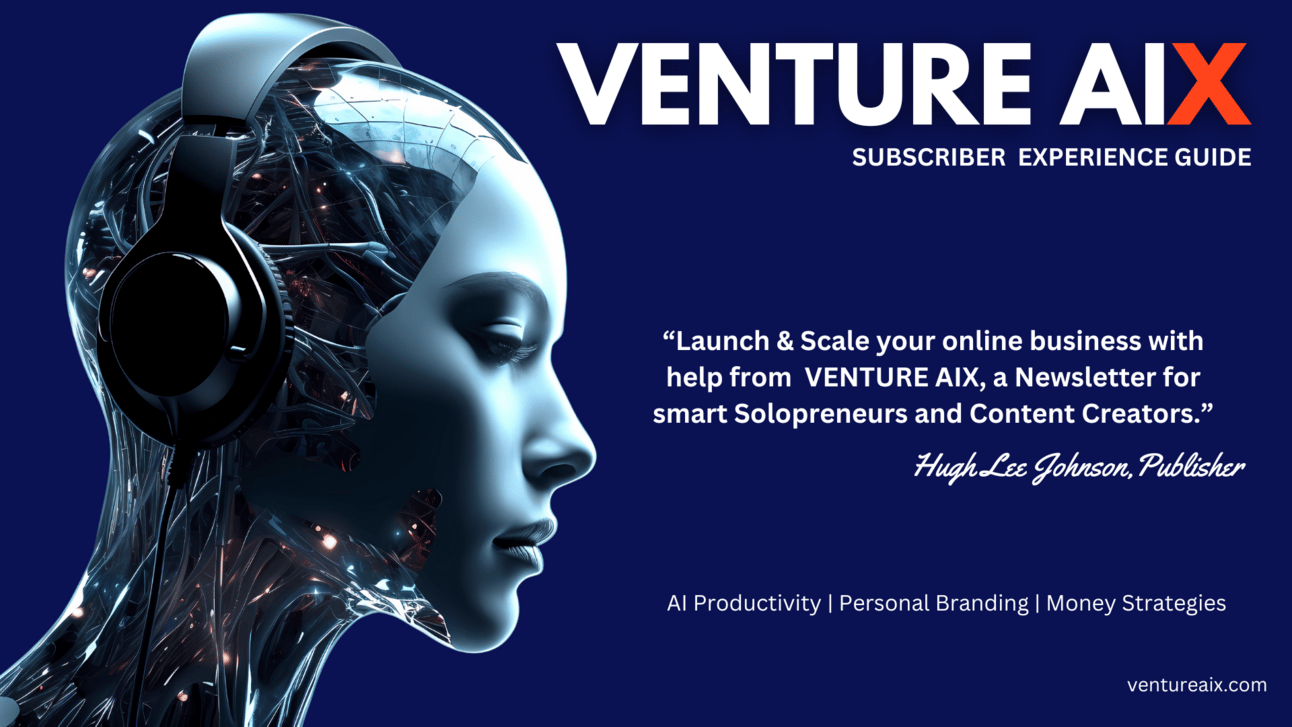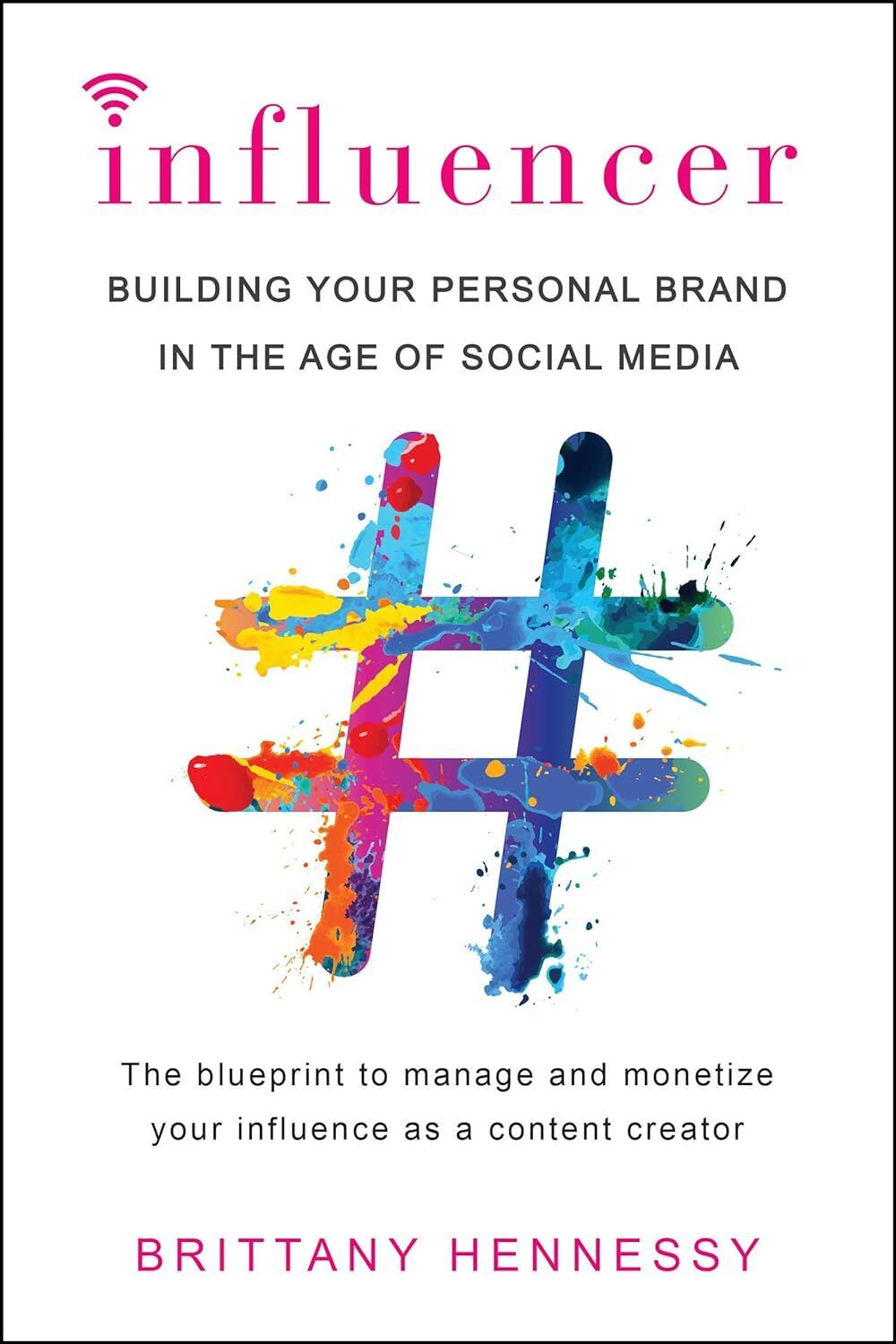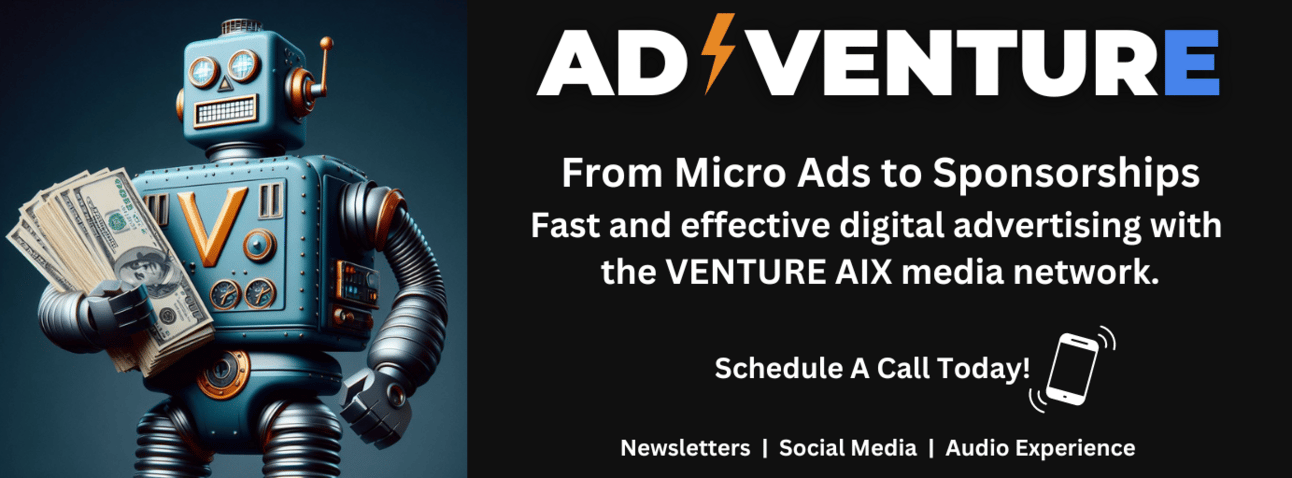In partnership with
QUIKCOACHES
Taking your business, product, or service to the next level is only a call away with QuikCoaches. Schedule your Business Success Call and see how our hybrid coaching system can help you! Life waits for no one… learn Quik.

Hello Venturian! In this week’s newsletter, we’ll do a deep dive into the importance of building a Personal Brand. What you will learn is pure gold that will serve you well along your journey to success.
How to Master Personal Branding includes actionable steps and a downloadable checklist to help you get started with implementing the jewels that will be shared in this week’s report.
As a bonus, a link to Gary Vee’s video tutorial on Personal Branding is included.
Your feedback and questions are welcome. Enjoy!

The Importance of Personal Branding for Solopreneurs
In today's competitive marketplace, standing out is more critical than ever, especially for solopreneurs. Whether you're a freelancer, consultant, or a small business owner, your personal brand is your unique selling point. It's what distinguishes you from the sea of competitors and allows you to build a lasting connection with your audience. But how do you cultivate a strong personal brand that resonates and converts?
This blog post aims to guide solopreneurs through the art of personal branding. You'll learn what personal branding entails, why it's essential, and seven actionable tips to help you create a compelling personal brand. By the end, you'll have the tools and insights needed to elevate your brand and drive your business forward.
Explanation of What Personal Branding Is and Its Key Components
Personal branding isn't just about having a logo or a catchy tagline—it's about the complete package that represents who you are and what you stand for. At its core, personal branding is the practice of marketing yourself and your career as a brand. It includes your skills, experience, values, and personality, all communicated consistently across various channels.
Key Components of Personal Branding
Unique Value Proposition: This is what sets you apart. It's a clear statement that describes the benefit you offer, who you offer it to, and why you're uniquely qualified to provide this benefit.
Brand Voice and Visual Identity: Your brand voice is how you communicate your message, while your visual identity encompasses your logo, color scheme, and overall aesthetic.
Online Presence: This includes your website, social media profiles, and any other digital platforms where you interact with your audience.
Content Strategy: Consistently producing valuable content that showcases your expertise is crucial for building and maintaining your personal brand.
Authentic Engagement: Genuinely interacting with your audience helps build trust and loyalty.
Insight into the Benefits of a Strong Personal Brand for Solopreneurs
Building a strong personal brand offers numerous benefits that can significantly impact your business's success.
Increased Credibility and Trust
When you have a well-established personal brand, people are more likely to trust you. This credibility can lead to more opportunities, whether it's landing new clients, speaking engagements, or partnerships.
Higher Visibility
A strong personal brand makes you more visible both online and offline. This increased exposure can lead to higher website traffic, more social media followers, and ultimately, more business opportunities.
Competitive Advantage
In a crowded marketplace, your personal brand is what sets you apart from your competitors. It highlights your unique strengths and expertise, making it easier for potential clients to choose you over others.
Stronger Client Relationships
A well-defined personal brand helps build stronger relationships with your clients. They feel more connected to you on a personal level, which can lead to long-term loyalty and repeat business.
7 Practical Tips for Solopreneurs to Enhance Their Personal Brand
Defining Your Unique Value Proposition
The first step in building a strong personal brand is defining your unique value proposition (UVP). Your UVP is a clear statement that explains what you do, who you do it for, and why you're unique. To craft a compelling UVP, consider the following:
Identify Your Strengths: Think about what you excel at and how these strengths can benefit your audience.
Understand Your Audience: Know who your target audience is and what they're looking for.
Differentiate Yourself: Highlight what makes you different from your competitors. This could be your approach, your experience, or a unique skill set.
Once you've defined your UVP, make sure it's prominently displayed on your website, social media profiles, and any other platforms where you interact with your audience.
Establishing a Consistent Brand Voice and Visual Identity
Your brand voice and visual identity are essential components of your personal brand. They help convey your message and create a cohesive look and feel across all your brand touchpoints.
Brand Voice
Your brand voice is how you communicate with your audience. It should reflect your personality and resonate with your target audience. To establish a consistent brand voice, consider the following:
Tone: Decide whether your tone will be formal or informal, serious or playful, etc.
Language: Choose language that reflects your brand's personality and is appropriate for your audience.
Consistency: Use your brand voice consistently across all your communication channels.
Visual Identity
Your visual identity includes your logo, color scheme, typography, and overall design aesthetic. To create a cohesive visual identity, follow these steps:
Logo: Design a logo that reflects your brand's personality and values.
Color Scheme: Choose colors that evoke the emotions you want your audience to feel.
Typography: Select fonts that are easy to read and align with your brand's tone.
Design Elements: Use consistent design elements, such as icons and images, to create a unified look.
By maintaining a consistent brand voice and visual identity, you'll create a cohesive and recognizable brand that resonates with your audience.
Social media is a powerful tool for building and promoting your personal brand. It allows you to reach a wider audience, connect with industry influencers, and engage with your followers. Here are some tips for leveraging social media effectively:
Choose the Right Platforms: Focus on the social media platforms where your target audience is most active. This could be LinkedIn for professional connections, Instagram for visual content, or Twitter for real-time updates.
Create Engaging Content: Share content that provides value to your audience, such as tips, insights, and behind-the-scenes glimpses of your work.
Engage with Your Audience: Respond to comments, participate in discussions, and show appreciation for your followers. Building genuine relationships with your audience can help strengthen your personal brand.
In addition to social media, networking is another valuable tool for building your personal brand. Attend industry events, join professional organizations, and connect with influencers in your field. Building strong relationships with others in your industry can lead to new opportunities and help you establish yourself as a thought leader.
Creating Valuable Content to Showcase Expertise
Creating and sharing valuable content is a key component of personal branding. It allows you to showcase your expertise, provide value to your audience, and establish yourself as a thought leader in your field. Here are some tips for creating valuable content:
Identify Your Audience's Needs: Understand what your audience is looking for and create content that addresses their needs and interests.
Share Your Knowledge: Offer insights, tips, and advice based on your expertise. This could be in the form of blog posts, articles, videos, or social media posts.
Be Consistent: Regularly share content to keep your audience engaged and maintain your visibility.
By consistently creating and sharing valuable content, you'll establish yourself as an authority in your field and build a loyal following.
Engaging with Your Audience Authentically
Authentic engagement is crucial for building a strong personal brand. When you genuinely engage with your audience, you build trust and foster meaningful connections. Here are some tips for engaging with your audience authentically:
Be Responsive: Respond to comments, messages, and emails on time. Show your audience that you value their input and appreciate their support.
Be Transparent: Be open and honest with your audience about your experiences, challenges, and successes. Transparency helps build trust and credibility.
Show Appreciation: Acknowledge and show appreciation for your audience's support. Whether it's a simple thank you or a shoutout on social media, showing gratitude goes a long way in building strong relationships.
By engaging with your audience authentically, you'll create a loyal and supportive community around your personal brand.
Seeking and Leveraging Testimonials and Reviews
Testimonials and reviews are powerful tools for building credibility and trust. Positive feedback from satisfied clients or customers can help attract new business and strengthen your brand. Here's how to seek and leverage testimonials and reviews:
Ask for Feedback: Reach out to your clients or customers and ask for their feedback. Be specific about what you'd like them to address in their testimonial or review.
Showcase Testimonials: Display testimonials prominently on your website, social media profiles, and marketing materials. Highlight the most impactful quotes and provide context for each testimonial.
Respond to Reviews: Whether positive or negative, respond to reviews professionally and courteously. Show that you value feedback and are committed to improving your services.
You'll build a strong reputation and enhance your brand's credibility by seeking and leveraging testimonials and reviews.
Continuously Evaluating and Adjusting Your Brand Strategy
Personal branding is an ongoing process that requires continuous evaluation and adjustment. Regularly assessing your brand strategy and making necessary adjustments can help you stay relevant and effective. Here are some tips for continuously evaluating and adjusting your brand strategy:
Monitor Your Progress: Track key metrics, such as website traffic, social media engagement, and client inquiries, to gauge the effectiveness of your brand strategy.
Gather Feedback: Seek feedback from your audience, clients, and peers to understand how your brand is perceived. Use this feedback to identify areas for improvement.
Stay Current: Keep up with industry trends and best practices to ensure your brand remains relevant. Be open to experimenting with new strategies and tactics to see what works best for your brand.
By continuously evaluating and adjusting your brand strategy, you'll ensure your personal brand remains strong and effective.
Real-Life Examples and Success Stories of Solopreneurs Who Have Effectively Built Their Personal Brands
Real-life examples and success stories can provide valuable insights and inspiration for building your personal brand. Here are two solopreneurs who have effectively built their brands:
Marie Forleo
Marie Forleo is a successful solopreneur, author, and motivational speaker. She built her brand by offering valuable content through her online platform, MarieTV, where she shares insights on business, personal development, and entrepreneurship. Her authentic and engaging brand voice has helped her build a loyal following and establish herself as a thought leader in her field.
Gary Vaynerchuk
Gary Vaynerchuk, also known as GaryVee, is a well-known entrepreneur, author, and social media influencer. He built his personal brand by sharing valuable content on social media platforms and offering practical advice on entrepreneurship, marketing, and personal development. His energetic and motivational brand voice has helped him build a large and engaged audience, making him a prominent figure in the business world.
Conclusion
In conclusion, personal branding is a crucial tool for solopreneurs looking to differentiate themselves and build a successful business. By defining your unique value proposition, establishing a consistent brand voice and visual identity, leveraging social media and networking, creating valuable content, engaging with your audience authentically, seeking and leveraging testimonials and reviews, and continuously evaluating and adjusting your brand strategy, you can build a strong and impactful personal brand.
Remember, personal branding is an ongoing process that requires dedication and effort. Start implementing these tips today and watch your personal brand grow.
Take what you have just learned to the next level. Download and complete the Personal Branding Checklist below:
The Top 10 AI Tools for Online Influencers
A new breed of Online Influencers are using AI tools to enhance their content creation, optimize their social media strategies, and engage with their audience. Here are the Top 10 AI tools for Influencers:
Hootsuite
Description: Social media management platform with AI features.
Features: Post scheduling, analytics, content curation.
Benefits: Streamlines social media efforts, and tracks performance.
Website: Hootsuite
Buffer
Description: Social media management tool with AI insights.
Features: Post scheduling, engagement analytics, content planning.
Benefits: Simplifies social media management, and tracks performance.
Website: Buffer
Sprout Social
Description: Comprehensive social media management platform.
Features: Scheduling, analytics, social listening.
Benefits: Enhances social media strategy, and improves engagement.
Website: Sprout Social
Canva
Description: AI-powered design tool for social media graphics.
Features: Templates, photo editing, drag-and-drop design.
Benefits: Simplifies graphic creation, and improves visual content.
Website: Canva
Later
Description: Social media scheduling and planning tool.
Features: Visual content calendar, post scheduling, analytics.
Benefits: Simplifies content planning, and improves scheduling efficiency.
Website: Later
Tailwind
Description: AI-powered Pinterest and Instagram marketing tool.
Features: Smart scheduling, content discovery, analytics.
Benefits: Enhances visual marketing, and improves engagement.
Website: Tailwind
BuzzSumo
Description: Content research and performance analysis tool.
Features: Trend analysis, influencer identification, content insights.
Benefits: Identifies top-performing content, and enhances strategy.
Website: BuzzSumo
SocialBee
Description: Social media management tool for content creation and scheduling.
Features: Content recycling, post scheduling, analytics.
Benefits: Streamlines content management, and improves engagement.
Website: SocialBee
Phlanx
Description: Influencer marketing platform.
Features: Engagement calculator, influencer search, campaign tracking.
Benefits: Identifies top influencers, and tracks campaign performance.
Website: Phlanx
Influencity
Description: Influencer marketing platform with AI analytics.
Features: Influencer search, audience analysis, campaign management.
Benefits: Enhances influencer marketing strategy, and tracks performance.
Website: Influencity
Book of the Week:
Influencer: Building Your Personal Brand in the Age of Social Media
Every one of your favorite influencers started with zero followers and had to make a lot of mistakes to get where they are today—earning more money each year than their parents made in the last decade. But to become a top creator, you need to understand the strategies behind the Insta-ready lifestyle . . .
As nightlife blogger, then social media strategist, and now Senior Director of Influencer Strategy and Talent Partnerships at Hearst Magazines Digital Media, Brittany Hennessy has seen the role of influencers evolve and expand into something that few could have imagined when social media first emerged. She has unrivaled insight into where the branded content industry was, where it is, and where it's going. In this book she'll reveal how to:
*Build an audience and keep them engaged
*Package your brand and pitch your favorite companies
*Monetize your influence and figure out how much to charge
Get your copy today HERE!
Are you ready to take your Solopreneur journey to the next level?
Venture AIX Pro is designed specifically for ambitious Solopreneurs and Content Creators like you who want to accelerate their success and achieve their goals faster.
Ready to Amplify Your Brand?
Join other successful businesses in reaching an audience primed for growth and innovation. Contact us today to learn more about our advertising options and start driving results for your business!

Download your copy below





